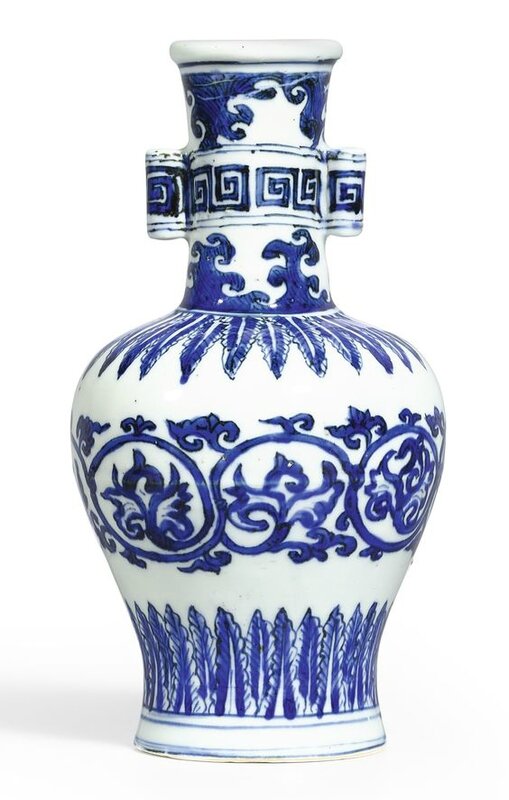A fine and rare blue and white 'arrow' vase, Mark and period of Wanli (1573-1619)


Lot 3716. A fine and rare blue and white 'arrow' vase, Mark and period of Wanli (1573-1619). Estimate 800,000 — 1,200,000 HKD. Lot sold 8,240,000 HKD. Photo Sotheby's.
modelled after a Xuande prototype, potted with a baluster body resting on a slightly splayed foot and surmounted by a gently waisted neck and lipped mouthrim, the neck flanked by a pair of tubular lug handles, the body painted in rich cobalt-blue tones with a continuous foliate scroll, between bands of plantain leaves encircling the base of the neck and the lower body of the vessel, the centre of the neck and handles bordered with a key-fret band, between two friezes of crashing waves, the countersunk base inscribed with a six-character reign mark within a double-circle; 18.7 cm, 7 3/8 in.
Provenance: Collection of Alan Abramson, Detroit, purchased in 1960s, by repute.
Notes: It is very rare to find a Wanli mark and period vase of this form and decoration, and no other closely related example appears to have been published. The Wanli Emperor is known to have been passionately fond of porcelain wares made in the Xuande (1426-35) and Chenghua (1465-87) reigns; hence a number of copies of these wares, but inscribed with the Wanli Emperor’s reign mark, was produced at the porcelain kilns in Jingdezhen. This vase belongs to this group and closely follows Xuande prototypes; see a Xuande mark and period vase in the Palace Museum, Beijing, illustrated in Gugong bowuyuan cang. Ming chu qinghua ci [Early Ming blue and white porcelain in the Palace Museum], Beijing, 2002, vol. 1, pl. 82; another in the National Palace Museum, Taipei, included in the Museum’s Special Exhibition of Hsuan-Te Wares, National Palace Museum, Taipei, 1980, cat. no. 8; and a third illustrated in Sekai toji zenshu/Catalogue of World’s Ceramics, vol. 11, Tokyo, 1955, pl. 70.
Vases of this type were later commissioned by the Yongzheng Emperor (r. 1723-35), a similarly keen collector of Xuande porcelains, who also had it recorded in the pictorial scroll Guwan tu [Scroll of antiques], on the sixth year of his reign (1729), later in the collection of Sir Percival David and now in the British Museum, London, included in the exhibition China. The Three Emperors 1662-1795, Royal Academy of Arts, London, 2006, cat. no. 168.
Sotheby's. Important Chinese Art, Hong Kong, 05 oct. 2016, 02:30 PM

/https%3A%2F%2Fprofilepics.canalblog.com%2Fprofilepics%2F1%2F0%2F100183.jpg)
/https%3A%2F%2Fstorage.canalblog.com%2F03%2F02%2F119589%2F96711876_o.jpg)
/https%3A%2F%2Fstorage.canalblog.com%2F11%2F31%2F119589%2F94773502_o.jpg)
/https%3A%2F%2Fstorage.canalblog.com%2F20%2F83%2F119589%2F94772815_o.jpg)
/https%3A%2F%2Fstorage.canalblog.com%2F26%2F72%2F119589%2F75604929_o.jpg)
/https%3A%2F%2Fstorage.canalblog.com%2F59%2F60%2F119589%2F26458628_o.jpg)


/image%2F1371349%2F20240416%2Fob_2a8420_437713933-1652609748842371-16764302136.jpg)
/image%2F1371349%2F20240414%2Fob_83ee65_2024-nyr-22642-0954-000-a-blue-and-whi.jpg)
/image%2F1371349%2F20240414%2Fob_15808c_2024-nyr-22642-0953-000-a-blue-and-whi.jpg)
/image%2F1371349%2F20240414%2Fob_e54295_2024-nyr-22642-0952-000-a-rare-blue-an.jpg)